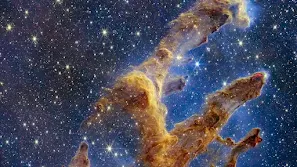Top 5 vibrant instruction images take by James web .
Combined observations from NASA’s NIRCam (Near-Infrared Camera) and Hubble’s WFC3 (Wide Field Camera 3) show spiral galaxy NGC 5584, which resides 72 million light-years away from Earth. Among NGC 5584’s glowing stars are pulsating stars called Cepheid variables and Type Ia supernova, a special class of exploding stars. Astronomers use Cepheid variables and Type Ia supernovae as reliable distance markers to measure the universe’s expansion rate.
NASA's $10 billion James Webb Space Telescope (JWST) launched on Dec. 25, 2021, from Europe's Spaceport in French Guiana. Since it arrived at its new cosmic home, Lagrange Point 2, on Jan. 24, 2022, the infrared observatory has been busy sharing some truly breathtaking views of the cosmos.
JWST, the largest and most powerful space telescope to date, released its first scientific images on July 12, 2022, but it didn't stop there.
The next-generation observatory continues to beam back jaw-dropping images. We explore some of the best of them here. You can scroll through the gallery using the navigation arrows above.
When JWST turned its attention to the iconic Pillars of Creation, the observatory showed the famous dust clouds in remarkable detail. Located in the constellation Serpens, approximately 7,000 light-years from Earth, the Pillars of Creation are part of the Eagle Nebula.
The vast clouds of gas and dust were famously photographed by the Hubble Space Telescope in 1995, bringing their remarkable beauty to light. The new photograph obtained by JWST reveals the pillars in even more detail and clarity. Hundreds of previously invisible stars shine throughout the image, some born only a few hundred thousand years ago.
Read more: Magnificent Pillars of Creation sparkle in new James Webb Space Telescope image
The full view of the James Webb Space Telescope's NIRCam (Near-Infrared Camera) instrument reveals a 50 light-years-wide portion of the Milky Way's dense center.
An estimated 500,000 stars shine in this image of the Sagittarius C (Sgr C) region, along with some as-yet-unidentified features.
The region of intense star formation lies just 300 light-years from the supermassive black hole sitting at the center of our galaxy, Sagittarius A*.
Read more: James Webb Space Telescope sees major star factory near the Milky Way's black hole (image)
Here, JWST has captured mysterious concentric rings surrounding a distant star that have scientists rather baffled. The star at the center of the image is known as WR140, a Wolf-Rayet star that has ejected most of its hydrogen into space and is surrounded by dust.
Mark McCaughrean, an interdisciplinary scientist in the JWST Science Working Group and a science advisor to the European Space Agency, called the feature "bonkers" in a Twitter thread.
"The six-pointed blue structure is an artifact due to optical diffraction from the bright star WR140 in this #JWST MIRI image," he wrote. "But red curvy-yet-boxy stuff is real, a series of shells around WR140. Actually in space. Around a star."
Read more: Mysterious rings in new James Webb Space Telescope image puzzle astronomers
This mind-bending JWST image of the galaxy cluster known as El Gordo gives us another mesmerizing view of the universe.
One subject, for instance, is known as "El Anzuelo," or "The Fishhook." Located 10.6 billion light-years away, this galaxy can be clearly seen toward the top right of the image as a bright red arc. To put into perspective how trippy this new photo is, you're seeing El Anzuelo as it was 10.6 billion years ago. This is because it took that long for light from this point in the galaxy's life to reach the JWST.
Read more: James Webb Space Telescope unveils the gravitationally warped galaxies of 'El Gordo'
.jpeg)






Post a Comment